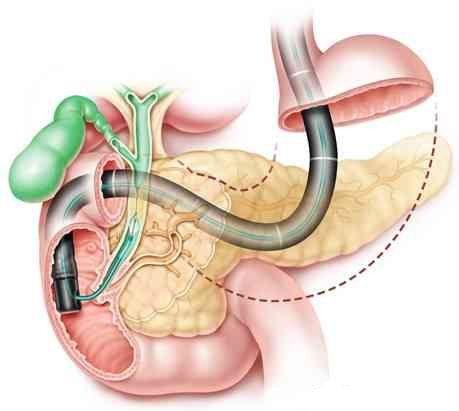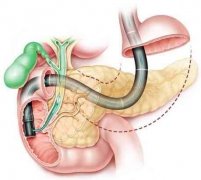 全覆膜与非全覆膜自膨式金属支架对于治疗胆管远端恶性狭窄的对比:一项系统评价和荟萃分析
全覆膜与非全覆膜自膨式金属支架对于治疗胆管远端恶性狭窄的对比:一项系统评价和荟萃分析
研究背景
自膨式金属支架(简称SEMS )常用于姑息治疗远端恶性胆管狭窄疾病,但是目前其中全覆膜的支架治疗效果还不是很明确。故进行了最新的临床荟萃分析,以比较不可切除的胆管远端恶性狭窄患者全覆膜金属支架和裸金属支架的治疗效果有无差异。
方法
在MEDLINE,EMBASE和Cochrane图书馆检索了2000年至2016年12月之间的所有比较胆管远端恶性狭窄患者全覆膜和裸金属支架随机试验。 主要统计指标是支架失败率和患者死亡率; 次要统计指标是支架不良事件和支架并发症。合并估计值是使用随机效应模型计算的。
结果
我们对从11个随机对照试验中纳入的1272名患者进行了统计分析。 结果是全覆膜金属支架与裸金属支架相比,支架置入失败率和患者死亡率之间没有统计学意义。(危险比[HR] 0.68,95%可信区间[CI] 0.40-1.17; HR 0.89,95%CI 0.76-1.05)。然而,支架移位和支架堵塞在全覆膜SEMS中更常见(比值比[OR] 5.11,95%CI 1.84-14.17;或2.46,95%CI 1.37-4.43)。 全覆膜金属支架肿瘤网眼内生长率较低(OR 0.21,95%CI 0.09-0.50),但与裸金属支架相比,肿瘤支架两端生长率(OR 2.00,95%CI 1.15-3.48)更高。 手术相关不良事件的发生率在两组相似。
结论
全覆膜金属支架支架植入失败率和患者死亡率降低约32%,但无统计学差异。 全覆膜SEMS支架移位率和堵塞率较高,而裸金属支架更容易发生肿瘤向内生长。 从数据分析中得出结论:全覆膜SEMS并没有更多的益处;其远期进展有待观察(即对于不能切除的胆管远端恶性狭窄患者的治疗全覆膜和裸金属支架的治疗效果无显著差异)。
.
Covered vs. uncovered self-expandable metal stents for malignant distal biliary strictures: a systematic review and meta-analysis
Tringali Alberto ,Hassan Cesare ,Rota Matteo ,Rossi Marta ,Mutignani Massimiliano ,Aabakken Lars
BACKGROUND
Self-expandable metal stents (SEMS) are used for palliation of distal malignant biliary strictures, but the role of covered SEMS is less clear. We performed an up-to-date meta-analysis to compare the performance of covered and uncovered SEMS in patients with unresectable distal malignant biliary strictures.
METHODS
A computerized medical search was performed using MEDLINE, EMBASE, and the Cochrane Library between 2000 and December 2016 to identify all randomized trials that compared covered with uncovered SEMS in patients with distal malignant biliary strictures. Primary outcomes were stent failure and patient mortality; secondary outcomes were stent dysfunction and adverse events. Pooled estimates were computed using the random effects model.
RESULTS
Overall, 11 RCTs involving 1272 patients were included. The primary outcomes of stent failure and patient mortality did not differ significantly between covered and uncovered SEMS (hazard ratio [HR] 0.68, 95 % confidence interval [CI] 0.40 - 1.17; HR 0.89, 95 %CI 0.76 - 1.05, respectively). However, stent migration and sludge formation were much more common with covered SEMS (odds ratio [OR] 5.11, 95 %CI 1.84 - 14.17; OR 2.46, 95 %CI 1.37 - 4.43). The use of covered SEMS was associated with a lower rate of tumor ingrowth (OR 0.21, 95 %CI 0.09 - 0.50) but a higher rate of tumor overgrowth (OR 2.00, 95 %CI 1.15 - 3.48) compared with uncovered stents. The rates of procedure-related adverse events were similar in both groups.
CONCLUSION
There was a risk reduction of about 32 % for both stent failure and patient mortality with covered SEMS but this difference was not significant. Migration and sludge rates were higher with covered SEMS, whereas tumor ingrowth was more likely with uncovered SEMS. The data show no added benefit of covered SEMS; further stent evolution is desirable.
翻译:王浩 审校:张立超、侯森林 (Endoscopy 2018-01-17刊稿)



